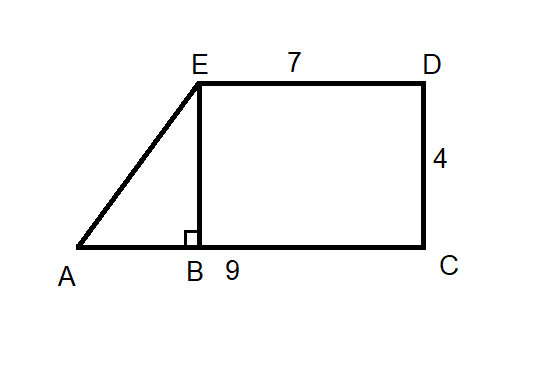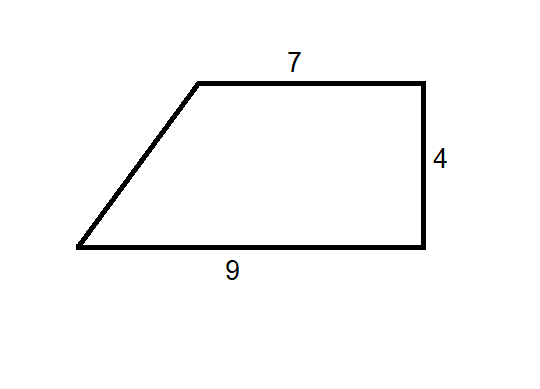
Answer
377.4k+ views
Hint: We draw the perpendicular line $EB\bot AC$. We break into rectangle and right-angled triangles and find their individual areas. We use the formulas of the area to find them and add to find the final solution.
Complete step by step answer:
We first need to break the given image of the trapezium into two parts: a rectangle and triangle according to the following image.

We draw $EB\bot AC$. Therefore, due to the parallel sides of the quadrilateral EBCD, it becomes rectangular as it has angles equal to ${{90}^{\circ }}$. We also have a right-angle triangle $\Delta ABE$.
We find individual areas and add them to find the area of the given figure in the problem.
For the rectangle EBCD the opposite sides are equal to each other.
Therefore, $ED=BC=7$ and also $EB=DC=4$.
The formula of area of rectangle is multiplication of unequal sides.
So, the area of EBCD is $4\times 7=28c{{m}^{2}}$.
The side AB can be found from the length of the sides AC and BC.
We have $AB=AC-BC=9-7=2$.
The formula of the area of the right-angle triangle is half of the multiplication of sides holding the right angle.
So, the area of $\Delta ABE$ is $\dfrac{1}{2}\times 4\times 2=4c{{m}^{2}}$.
Therefore, the area of EACD is the sum of the area of EBCD with the area of $\Delta ABE$.
This gives $ar\left( EACD \right)=28+4=32c{{m}^{2}}$.
So, the correct answer is “Option C”.
Note: The quadrilateral cannot be square as it doesn’t have equal sides although it has angles of ${{90}^{\circ }}$. The area for regular trapezium comes from this where we have half of the multiplication of sum of the opposite non-oblique sides and the height of the figure.
Complete step by step answer:
We first need to break the given image of the trapezium into two parts: a rectangle and triangle according to the following image.

We draw $EB\bot AC$. Therefore, due to the parallel sides of the quadrilateral EBCD, it becomes rectangular as it has angles equal to ${{90}^{\circ }}$. We also have a right-angle triangle $\Delta ABE$.
We find individual areas and add them to find the area of the given figure in the problem.
For the rectangle EBCD the opposite sides are equal to each other.
Therefore, $ED=BC=7$ and also $EB=DC=4$.
The formula of area of rectangle is multiplication of unequal sides.
So, the area of EBCD is $4\times 7=28c{{m}^{2}}$.
The side AB can be found from the length of the sides AC and BC.
We have $AB=AC-BC=9-7=2$.
The formula of the area of the right-angle triangle is half of the multiplication of sides holding the right angle.
So, the area of $\Delta ABE$ is $\dfrac{1}{2}\times 4\times 2=4c{{m}^{2}}$.
Therefore, the area of EACD is the sum of the area of EBCD with the area of $\Delta ABE$.
This gives $ar\left( EACD \right)=28+4=32c{{m}^{2}}$.
So, the correct answer is “Option C”.
Note: The quadrilateral cannot be square as it doesn’t have equal sides although it has angles of ${{90}^{\circ }}$. The area for regular trapezium comes from this where we have half of the multiplication of sum of the opposite non-oblique sides and the height of the figure.
Recently Updated Pages
How many sigma and pi bonds are present in HCequiv class 11 chemistry CBSE

Mark and label the given geoinformation on the outline class 11 social science CBSE

When people say No pun intended what does that mea class 8 english CBSE

Name the states which share their boundary with Indias class 9 social science CBSE

Give an account of the Northern Plains of India class 9 social science CBSE

Change the following sentences into negative and interrogative class 10 english CBSE

Trending doubts
Fill the blanks with the suitable prepositions 1 The class 9 english CBSE

Which are the Top 10 Largest Countries of the World?

Give 10 examples for herbs , shrubs , climbers , creepers

Difference Between Plant Cell and Animal Cell

Difference between Prokaryotic cell and Eukaryotic class 11 biology CBSE

The Equation xxx + 2 is Satisfied when x is Equal to Class 10 Maths

Change the following sentences into negative and interrogative class 10 english CBSE

How do you graph the function fx 4x class 9 maths CBSE

Write a letter to the principal requesting him to grant class 10 english CBSE




